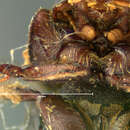Comprehensive Description
provided by Smithsonian Contributions to Zoology
Rhyssemus scaber Haldeman
Rhyssemus scaber Haldeman, 1848:107.—Horn, 1871:290; 1887:88.—Leng, 1920:251.—Schmidt, 1922:503.
MALE.—Length 3.3 mm, greatest width 1.5 mm. Elongate, widest behind middle of elytra, lateral margin of elytron not straight. Color dark reddish brown, pronotum and elytron black. Surface of head tuberculate, tubercles discrete, becoming smaller and denser toward posterior margin; anterior clypeal margin distinctly emarginate between rounded angles, feebly, narrowly reflexed. Pronotum 1.0 mm long by 1.25 mm wide; closely, densely tuberculate, with 4 transverse ridges, tubercles large on ridges, small in furrows, posterior 3 ridges narrowly broken at middle (Figure 1); lateral and basal borders narrowly margined, with a fringe of closely spaced, flattened setae. Elytra 2.2 mm long, 1.5 mm wide, humerus sharply dentate; striae deeply impressed, coarsely punctured, punctures separated by 2 to 3 times their diameter; interval wide, flat, with median costa, costa narrowly, irregularly broken, an elongate tubercle present at inner margin of interval opposite each strial puncture. Mesosternum densely punctured, feebly carinate between coxae. Metasternal midline distinctly impressed, extending from apex to base of metasternum; surface smooth, feebly alutaceous medially, becoming strongly alutaceous and roughened laterally. Abdominal sterna alutaceous, dull with narrow fluting on anterior margin, fluting becoming longer on successive sterna, each sternum with a row of indistinct tubercles extending from lateral border nearly to midline. Pygidium rough with scattered, fine tubercles and alutaceous sculpture, 2 erect setae present apically. Foretibia smooth with 3 lateral teeth, the posterior tooth at middle of tibia; spur long, slender, slightly sinuate, angled slightly downward. Middle and hind tibiae equal in length to femora, each apex fringed with short, somewhat unequal setae and 2 spurs, outer spur short, straight, half as long as inner spur, inner spur slightly longer than first tarsal segment, feebly sinuate. Hind tarsus shorter than tibia, basal segment as long as 2nd and 3rd combined, segments 2–4 successively decreasing in length, 5th segment nearly twice as long as 4th. Genitalia with lateral lobe short, broad, feebly bent downward at apex; internal sac lined with tiny teeth (Figure 18).
FEMALE.—Similar to male except the pygidium is wider and the penultimate abdominal sternum slightly longer at middle.
VARIATION.—Length 3.2 to 3.4 mm, width 1.5 to 1.8 mm. The dorsal color varies from black to a light reddish brown. The reddish-brown specimens are nearly always slightly teneral. The carinae on the elytral intervals are not as strongly raised in some specimens and are occasionally broken into narrow, elongate tubercles.
TYPE-LOCALITY.—“Middle States.”
TYPE DEPOSITORY.—Museum of Comparative Zoology, Harvard University.
- bibliographic citation
- Gordon, Robert Donald and Cartwright, Oscar Ling. 1980. "The Western Hemisphere species of Rhyssemus and Trichiorhyssemus (Coleoptera, Scarabaeidae)." Smithsonian Contributions to Zoology. 1-29. https://doi.org/10.5479/si.00810282.317
Rhyssemus scaber: Brief Summary
provided by wikipedia EN
Rhyssemus scaber is a species of aphodiine dung beetle in the family Scarabaeidae. It is found in North America.
- license
- cc-by-sa-3.0
- copyright
- Wikipedia authors and editors

